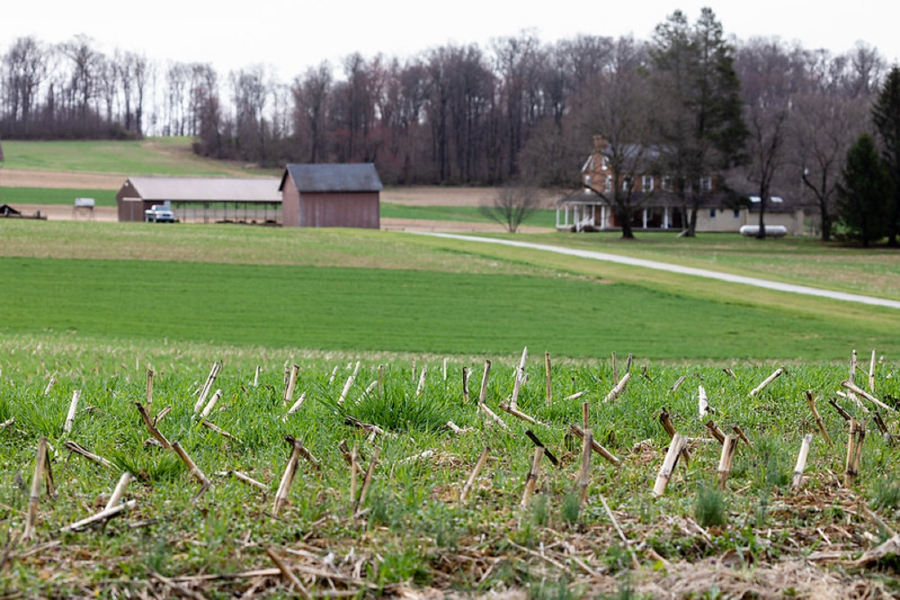Watershed jurisdictions help lower nutrient and sediment pollution entering the Bay
Bay model shows slight decline of pollution in 2021, thanks to agricultural conservation practices

Each year, the seven jurisdictions that make up the Chesapeake Bay watershed (Delaware, the District of Columbia, Maryland, New York, Pennsylvania, Virginia and West Virginia) report to the Chesapeake Bay Program the many conservation practices that they have installed across farmlands, cities and wastewater treatment plants to help reduce pollution flowing into their local waterways. From there, these data are entered into a complex modeling system that determines the amount of pollution that will be reduced thanks to the implementation of these practices.
Under the Chesapeake Bay Watershed Agreement, the partnership has committed to having 100% of pollution-reducing practices in place by 2025 that would achieve the nitrogen, phosphorus and sediment reductions necessary to meet the goals outlined in the Chesapeake Bay Total Maximum Daily Load (Bay TMDL). Estimates from the Watershed Model show that between 2009—the baseline for the Bay TMDL—and 2021:
- Overall nitrogen decreased 14%, from 297.8 million pounds in 2009 to 257.53 million pounds in 2021, meeting 49% of the goal to reduce nitrogen by 2025.
- Overall phosphorus decreased 14%, from 17.2 million pounds in 2009 to 14.7 million pounds in 2021, meeting 64% of the goal to reduce phosphorus by 2025.
- Overall sediment decreased 4%, from 18.9 billion pounds in 2009 to 18.1 billion pounds in 2021, meeting 100% of the goal to reduce sediment by 2025.
By using the best available data in our Watershed Model, the Chesapeake Bay Program can more accurately track each jurisdiction’s progress toward meeting their pollution reducing goals under the Bay TMDL. It provides a more complete view of how the installation of pollution-reducing practices and improved management actions are helping to keep Bay waters clean and healthy. For instance, here is how each of the six watershed states and the District of Columbia are doing in meeting their Bay TMDL goals:
- In Delaware, reported pollution controls achieved 20% of the 2025 reduction goal for nitrogen, 52% of the reduction goal for phosphorus and 63% of the reduction goal for sediment. The state did not meet its 2021 pollution reducing targets for nitrogen, phosphorus and sediment.
- In the District of Columbia, reported pollution controls achieved 100% of the 2025 reduction goals for nitrogen, phosphorus and sediment.
- In Maryland, reported pollution controls achieved 58% of the 2025 reduction goal for nitrogen, 74% of the reduction goal for phosphorus and 100% of the reduction goal for sediment. The state did not meet its 2021 pollution reducing targets for nitrogen and phosphorus but did meet its target for sediment.
- In New York, reported pollution controls achieved 69% of the 2025 reduction goal for nitrogen, 76% of the reduction goal for phosphorus and 21% of the reduction goal for sediment. The state did not meet its 2021 pollution reducing target for each of its 2021 pollution reducing targets.
- In Pennsylvania, reported pollution controls achieved 22% of the 2025 reduction goal for nitrogen, 48% of the reduction goal for phosphorus and 45% of the reduction goal for sediment. The Commonwealth did not meet its 2021 pollution reducing targets.
- In Virginia, reported pollution controls achieved 75% of the 2025 reduction goal for nitrogen, 68% of the reduction goal for phosphorus and 100% of the reduction goal for sediment. The Commonwealth did not meet its 2021 pollution reducing targets for nitrogen and phosphorus but met its target for sediment.
- In West Virginia, reported pollution controls achieved 100% of the 2025 reduction goal for nitrogen, 97% of the reduction goal for phosphorus and 100% of the reduction goal for sediment. The state has met each of its 2021 pollution reducing targets.
Historically, many of the nitrogen, phosphorus and sediment reductions came from upgrades made to wastewater treatment plants, that helped them to better filter pollution. However, in 2021, several permit violations occurred at wastewater facilities in Maryland that actually increased the amount of nitrogen and phosphorus that entered the Bay.
On the other hand, adding some good news into the mix, 77% of nitrogen reductions in the past year came from the agricultural sector. Declines in phosphorus and sediment pollution also came from the agricultural sector, but also the natural sector, which includes forests, stream beds and banks, wetlands and shorelines. Both the agricultural and natural sector are considered “non-point sources” of pollution, which typically experience a longer delay between installation and improvement in water quality.
Emily Dekar, a member of the Chesapeake Bay Program’s Agriculture Workgroup, as well as the agricultural coordinator with the Upper Susquehanna Coalition, lauded the efforts of the New York agricultural community by saying that “New York's primary focus is to address local water quality issues through best management practice implementation. Even though we are far from the Bay, every practice implemented provides nutrient and sediment reduction benefits, locally and downstream to the Chesapeake Bay.”
But she also cautioned, “while NY has made great progress towards meeting our Chesapeake Bay TMDL goals, we still have a ways to go. We continue to seek out additional funding opportunities for our farmers and landowners to assist with practice implementation costs, making high quality and larger scale projects more feasible."
Do you part in helping to keep the Bay clean and healthy by visiting our How To’s and Tips page.

Comments
There are no comments.
Thank you!
Your comment has been received. Before it can be published, the comment will be reviewed by our team to ensure it adheres with our rules of engagement.
Back to recent stories